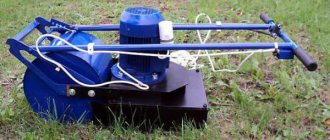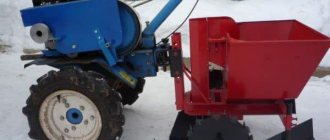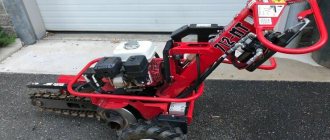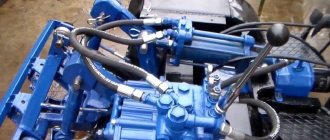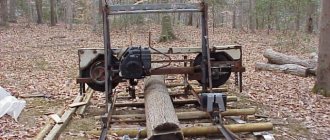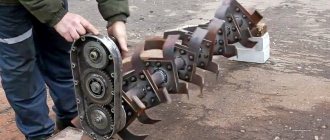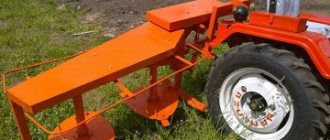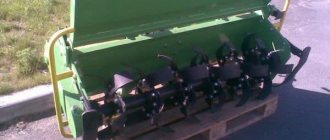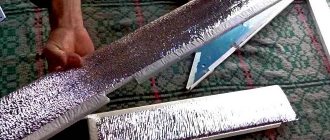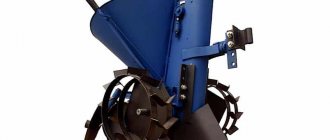A cultivator is a type of gardening equipment that replaces manual labor when cultivating the land: it loosens the soil and forms beds. With its help, you can very quickly weed and apply fertilizers. This device is a mechanized hoe with an electric drive.
Such a unit is not suitable for large areas and development of virgin soil. But in small areas, especially where planted trees and shrubs interfere with the use of larger equipment, a homemade electric cultivator is simply irreplaceable.
What is an electric cultivator and where is it used?
An electric cultivator is an electrically driven device designed to replace manual labor in cultivating the soil: loosening the soil, applying fertilizers, forming beds, and weeding.
Thus, it can be called a "mechanized hoe". It should be noted that the unit is not at all designed for working on large areas or for raising virgin soil (unlike powerful “hard workers”: a mini tractor or a walk-behind tractor with a plow). But it will serve well in flower beds, small vegetable beds and in areas between garden trees.
Thanks to its electric power supply, this unit is an absolutely environmentally friendly device, unlike its gasoline-powered counterparts that run on gasoline, so it can be used in closed environments (for example: greenhouses and hotbeds).
In addition, electric cultivators have other advantages compared to gasoline walk-behind tractors, namely:
- light weight of the device (allows women and pensioners to use it successfully);
- compact dimensions (provide ease of transportation and storage);
- ease of maintenance (does not require special skills);
- low cost (makes them accessible to a wide range of buyers)
Lawnmower from a used motor
We continue to look for the answer to the question of where we can use the motor from an automatic washing machine. Another original idea is making a lawn mower. For a small area, an electric model connected to a power source with a cord is quite sufficient. The design of such a unit is very simple. You will need to make a platform on four wheels with a small diameter.
The platform can be made of metal or OSB board, plywood and even the body of the same washing machine
The engine is fixed on top of the platform, the shaft is threaded into the hole below, and the knife is attached to it. All that remains is to attach handles and a lever to the cart to turn the power on and off. If you have an asynchronous motor lying around, you will be surprised at how quiet the unit will be, even compared to factory models.
Advice! To prevent grass from wrapping around the knives, you need to slightly bend their cutting edges down.
Video: how to make a lawn mower
Toothed manual plower
If it is necessary to loosen the soil to a shallow depth, hand plows with toothed elements are used. The tool consists of several disks made of steel and fixed on one axis, on the surface of which L-shaped pins are welded or screwed.
Discs
must have significant weight so that the pins can stick into the ground without additional effort. A U-shaped frame of suitable height is used as a holder for disks so that the rotating elements do not touch it.
In the middle of the frame, on the opposite side from the disks, in a perpendicular direction, a handle is screwed onto bolts. Both wood and metal can be used as a material for the handle, the main thing is to ensure the required level of structural strength.
Its production is similar to that described for the Tornado cultivator.
Steel wheels
usually made in quantities of 5 from solid metal, which reduces physical stress and ensures efficient operation. The diameter of the discs is made equal to at least 150 mm to ensure better loosening, and the thickness is sufficient for attaching the pins.
First, they are turned on a milling machine, and then the required number of holes are drilled in diameter and an M8 or M10 thread is cut inside for pins in an amount of 4. They are distributed evenly over the disk with the same distance from each other.
Axis
must withstand the full load of all elements without deflection or deformation, so its diameter must be from 20 mm. At the ends of the axle, threads are cut for the nut. The length of the axle should take into account the width of the disks, as well as provide the necessary space for installing bearings at the points of attachment to the frame.
After this, the finished discs are put on the axle, and then inserted into the frame and securely screwed on the sides with nuts. The handle is attached to the frame by welding or bolts.
For the purpose of automating the tine cultivator
perform the following actions:
- the axle is made longer by the width of the coupling;
- from the outside of the frame it is firmly fixed;
- An electric motor with a coupling is attached to the bottom of the cultivator holder;
- install a belt that transmits torque from the engine to the axle.
At the same time, by using different diameters of couplings, it is possible to regulate the transmitted force, as well as the speed of movement of the unit.
What else can be made from a washing machine drum: original decor ideas
The drum with its correct perforation is a material for the manufacture of decorative objects. Here are some interesting ideas.
Ottoman with drum base. It’s easy to do – you just need to attach the wheeled legs and make a soft seat
Such a drum can also be turned into an original lamp. If you place a lamp inside, the perforated surface of the drum will cast glare on the walls. Such lamps will look good on the ceiling of the veranda or even on the floor
Bedside tables and tables. Drums with doors from top-loading machines can be used to hide small items.
This is how the drum turns into a cabinet or nightstand
From a chainsaw
You can create a motorized cultivator with your own hands from a chainsaw. A powerful chainsaw of domestic or foreign production is used as the basis. It is advisable to take the “Friendship” model, because... it is cheaper than imported devices and has the required characteristics.
The garden assistant based on “Friendship” accelerates to 2.5 km/h and the power value is 4 hp. With.
The step-by-step assembly guide is as follows:
- The main halyard is equipped with a collar flange. This is necessary for the subsequent connection of bridge gearboxes.
- Next, sprockets are taken (can be from an old UAZ) and a double-row chain. Parts are needed to raise the distance from the geared axle to the ground. Timing sprockets can increase the distance by 15 cm.
- Housing bearings and a gearbox are installed on the key bridge.
- To fix the cutting elements, you need to use a steel pipe. In this case, it is important to ensure that the direction of the cutters corresponds to the movement of the walk-behind tractor.
- After completing the assembly work, a load is attached to the frame that can maintain the center of gravity.
- For convenient control of the unit, it is equipped with handles.
At the last stage, it is necessary to check the homemade cultivator for functionality. If there are defects or operational problems, they are eliminated.
Homemade products from a washing machine engine: circular saw
You will be surprised, but a circular machine can also be built based on the motor from a washing machine. An important point in this matter is the additional equipment of the motor with a device that regulates speed. Without this additional module, the circular machine will work unevenly and simply will not cope with the task. Device assembly diagram:
Circular saw diagram
The principle of operation of the device is simple: the engine drives a shaft on which a small pulley is mounted. From the small pulley there is a drive belt to a large pulley with a circular saw.
Important! When working with a homemade circular saw, take care of your hands. All structural parts must be firmly fixed.
The resulting unit will not be very powerful, so it can only be used for cutting boards up to 5 cm thick. How this homemade circular saw works:
How to make a cultivator with your own hands: simpler options
There is such a cultivator - “Nimble Baby”. Let's look at how you can make one at home. Take the wooden axle. It will become the connecting elements for the remaining parts. It is necessary to attach a pipe 24 mm in diameter to this axis. It will serve as a handle, so in order not to bend too much, choose the length of the pipe to suit your height.
Attach wheels with a diameter of no more than 200 mm to the mentioned axle. the cultivator will rest on wheels, the height of the tool above the ground depends on the height of the wheels that we have adapted to it. By the way, the wheels need to be cut out of metal 2-3 mm thick. After you have connected everything indicated, you can work on the ground.
The word cultivator does not only mean motor units. You can also use hand tools at your dacha. It is much better than a standard hoe and much easier to make at home than a motor cultivator. Have you heard about the Tornado cultivator? It looks like a defective pitchfork.
A round axle to which twisted teeth are welded in a spiral. This type of tool is easiest to make from existing forks, if you don't mind. If you still need your pitchforks, buy others from the store and make a “Tornado” out of them. Believe me, it is cheaper to buy forks and remake them than to buy a ready-made cultivator. Take a hammer and go over the teeth, letting them bend in a spiral.
We properly disassemble and decide what can be made from parts of an old washing machine
Disassembling a washing machine is a leisurely task. After working with water, a salt build-up may remain on the parts; it must be carefully removed so as not to damage the parts during removal. What can be made from an old washing machine? A motor will be useful for homemade projects - it will become the basis for many devices. The drum will also come into play. It is usually made of stainless steel. All pipes must be disconnected from the drum. A loading hatch may also be useful. In addition to these parts, do not rush to throw away springs, counterweights and body parts.
For those who are versed in electronics, you may need a circuit board - it can easily be used to find spare parts for repair work if necessary.
Classification and principle of operation
The design and operating principle of the unit are not very complicated.
That is why many summer residents decide to make an electric cultivator with their own hands.
Drawings of the device prove that it is quite possible. The main design elements are:
- Power point.
- Gearbox.
- Frame.
- Opener.
- Milling cutter.
Choosing a cellular signal amplifier for a summer residence
The frame houses the electric motor and gearbox. The working parts - opener and cutters - are installed on the output shaft of the last element. The steering wheel with handle is attached to the frame using a mating element.
The frame also has a wheelbase. The depth of the dig can be adjusted using a bolted opener or a handle.
The average productivity of industrial units is about 3 acres per hour.
A similar indicator can be achieved with a homemade device.
Nowadays you can find a large number of cultivator models on sale, differing in technical characteristics. Most often, these units are classified according to the following parameters:
- Weight - lightweight models weigh no more than 10 kg.
- Power - the range is quite large and ranges from 1 to 12 hp. With.
- Number of attachments - when choosing, a summer resident should decide on the possible range of work, since the required number of attachments depends on this factor.
Manufacturing recommendations
Before starting work, you must carefully study the drawings of the electric cultivator (it is impossible to assemble it yourself without them) and select the necessary materials.
To reduce manufacturing costs, you can use an electric motor from any household appliance, such as a washing machine. You shouldn’t buy wheels, because they can be taken from a broken-down country car. It should be said that today the LopLosh cultivator has become quite popular. The peculiarity of its design is the vertical arrangement of the cutters. However, some summer residents prefer to create simpler units. It doesn’t matter whether the cultivator is made from an angle grinder or from a washing machine. The sequence of actions and design will not undergo significant changes.
Plow body
The basis of the plow body is a triangular wedge ABCO. Its parameters are used during the design of a specific structure, which give it technological and operational properties.
Angle a, which is located in the longitudinal-vertical plane, is responsible for crumbling and bending of the soil layer. The wrapping of the earth layer occurs due to the angle in, located in the transverse-vertical plane.
To move the layer to the side, the angle y, lying in the horizontal plane, corresponds. Thanks to these parameters, bending and crumbling of the earth layer occurs.
All these parameters are interconnected by a trigonometric relationship:
Based on this, only two angles are randomly changed. To determine the third, the values of the first two are used. Quite an important conclusion for any designer. If you change one or another parameter, the triangular wedge acquires a plow-mouldboard surface of a certain type: helical (angle b), cylindrical (angle a), cylindrical (angle y), standard.
Knowing all the necessary parameters, making a plow for an electric cultivator will not be a problem.
Homemade electric cultivator: photo, description, as well as a video showing the device in operation.
Craftsman Stanislav Iosifovich made a homemade electric cultivator with his own hands to cultivate his garden. The basis of the design of a homemade cultivator is a three-phase electric motor and a gearbox that rotates the cultivator cutters. Wheels from VAZ are also installed. The weight of the device is 300 kg, and the working width is 116 cm.
We were cultivating a plot at the dacha; with a regular shovel it would have taken 2.5 hours, but this cultivator plowed the plot in 25 minutes.
From the electric motor to the gearbox there is a belt drive, from the gearbox there is a chain drive for the rotation of the shaft with cutters.
Cultivator instead of a shovel
Hectares of dug up and loosened soil will not add either strength or health. Especially if the tedious procedure must be carried out every spring and autumn. And digging up 6 acres by hand is a labor-intensive task.
An electric cultivator can help the summer resident, facilitate and speed up the process. Garden tools cultivate and loosen the soil, revealing its layers, and break up the earthen lump, saturating it with oxygen. With the help of an electric assistant, you can remove weeds and hill up plants.
Electric cultivator
Attention! The choice of the tool you need depends on the type of beds and the set of crops grown. If this is a greenhouse or a zoned area with a flower bed, vegetable garden and garden, then light manual options are suitable. To handle large areas, higher-end power tools are required.
The approximate cost of a cultivator created in industrial conditions varies from 5 to 30 thousand rubles. depending on the type. And if you also need a lawn mower, a lighting system for seedlings, drip irrigation in a greenhouse, and much more that you want to mechanize and improve, then this amount can be saved.
Hand cultivator
To help the farmer - 5 cultivator options, collected and tested by Russian summer residents. To create inventions, you can use ordinary tools and spare parts that you have on hand.
Cultivator: purpose and characteristics of types
Cultivators are very convenient and popular agricultural tools used to perform surface loosening of the soil, as well as destroying weeds, applying fertilizers and cutting furrows for irrigation activities. When choosing a model of such equipment, you must be guided by the following basic parameters:
- relief features of the site;
- useful area of the site;
- qualitative composition and characteristics of the soil;
- scope and criteria of assigned tasks.
Depending on the purpose, there are several main types of agricultural cultivators:
- continuous tillage during pre-sowing tillage with simultaneous harrowing;
- inter-row tillage of the soil and simultaneous fertilizing of cultivated crops with basic mineral fertilizers;
- pre-sowing tillage, represented by loosening and layer-by-layer grinding of the soil, as well as the destruction of weeds, leveling and compacting the soil.
Equipment can also be classified depending on the operating mechanisms:
- electrical equipment used in small garden plots. Operation is ensured by electricity. The equipment is lightweight, compact in size and does not emit harmful substances into the environment. Disadvantages include low power and low mobility;
- battery equipment designed for soil treatment in small areas. The difference from electric models is sufficient mobility while maintaining small dimensions;
- Gasoline equipment is the most popular due to its high performance. Such units are quite powerful, mobile and convenient. The main disadvantages of the application are the emissions of harmful substances into the atmosphere, as well as the need to regularly perform competent maintenance.
Another fairly popular type of garden equipment among owners of country property is a hand-held cultivator, represented by a simple design in the form of bent hook fingers or metal stars, which are attached to a metal holder.
Making a barbecue from a drum from a washing machine, photo examples
A metal grill is a temporary product. Sooner or later it burns out and requires replacement. You can buy a new one each time or use improvised material, for example, a drum from a washing machine. Making this craft from a washing machine drum takes a couple of minutes. The beauty is that oxygen easily enters the perforated container, which causes active combustion.
Kebab coals burn quickly, and the process of cooking meat is significantly accelerated
The metal of the drum can withstand a couple of seasons. Make a comfortable stand for it so you don’t have to bend over, and you’re done. Standard length skewers will fit comfortably on a small roasting pan. If necessary, you can lightly weld a couple of guides.
Popular models
Before ordering a manual cultivator for your garden, read and compare the characteristics of common models. Also take into account their pros and cons. Popular hand cultivators:
| Price in rubles | Characteristics | pros | Minuses |
| 1889 | Type – star-shaped; length – 37.7 cm, weight – 0.865 kg, working width – 14 cm, material – steel, handle/handle attachment – combisystem. | Convenient, effective, lightweight, easy to use. | No handle/handle included, more expensive than alternative options. |
| Price in rubles | Characteristics | pros | Minuses |
| 1299 | Type – root remover, weight – 2000 g, dimensions (in package) – 68x20x20 cm, loosens soil to a depth of 20 cm. | You can loosen the soil of almost any density, remove small and large weeds, and can adjust the length of the boom. | Difficult to work on hard, trampled ground (requires a lot of effort), difficulties may arise during assembly. |
| Price in rubles | Characteristics | pros | Minuses |
| 2479 | Includes 2 telescopic handles with adjustable length, handle height - 100-150 cm, tooth length - 28 cm, material - high-carbon spring steel, folded dimensions - 58x100x10 cm, weight (packaged) - 6960 g. | Crushes the soil to a depth of 25-28 cm, does not turn the soil over, high processing speed. | Not suitable for digging up virgin soil, larger and more expensive than analogues. |
| Price in rubles | Characteristics | pros | Minuses |
| 774 | Type - disk, purpose - cultivation, loosening, main mechanism - star-shaped disks, material - steel, tool width - 14 cm, packaged dimensions - 13.5x34x15.5 cm, packaged weight - 690 g. | Reasonably priced, relatively lightweight, easy to use, copes well with cutting through soil. | The handle will have to be purchased separately; the knives are held in the fork by plastic plugs. |
| Price in rubles | Characteristics | pros | Minuses |
| 929 | Type - rotary with handle and weeding knife, length - 147 cm, purpose - digging and leveling the soil for sowing, coating of the metal part - powder enamel, handle - wooden, packaged dimensions - 169x21x12 cm, packaged weight - 1860 g. | Reasonable cost, availability of cuttings, loosens sandy soil well, cuts weeds. | The small width of the working part and the length of the handle may not be optimal for all family members. |
The simplest option is a homemade tornado cultivator
Making a manual cultivator with your own hands, according to folk craftsmen, is a simple process that even an amateur can do. The undoubted benefits of such an acquisition will become obvious in the very first days of use in the garden. After all, cultivation is an indispensable stage of crop care, which cannot be avoided even when growing bushes and trees.
At the initial stage, loosening and weeding help preserve the crops produced, save on watering, and avoid the proliferation of weeds and pests.
Tips and instructions for choosing a model of the simplest device can be found here:
And if the Tornado model became the object of preference, then here is a video from the author of one of the variations:
The homemade Tornado hand cultivator requires only three parts to make the device:
- The working part is the main component of the device, which determines the ease of use and reliability in performing processes. Visually, it looks like steel rods twisted in a spiral and securely fastened to the central axis. As soon as the central part rotates in the soil in any direction, it wraps around the weed that is deep in the ground and brings it out. It is especially convenient to extract the entire weed plant, along with the root, from which it can potentially continue to grow.
- The handle is used as a part onto which the remaining parts of the device are attached. Advice from experienced gardeners recommend not to bother too much with finding a suitable part. Usually it is simply purchased at the market or supermarket. A fork or shovel handle is ideal for this purpose - it is already smoothly planed and made of fairly durable wood. You just need to calculate in advance what length of wood will be optimal for making and using the Tornado.
- Pen. The method of manufacturing and fastening the handle, which acts as a kind of lever, can be found in different ways. Options are offered from a plastic pipe attached to the handle of a shovel using tape, there are tips for attaching a more durable lever using self-tapping screws, and using metal pipes. The approximate length of this part varies from 50-60 cm, but if one person works as a cultivator, he can simply rely on his own convenience.
Drawing of a homemade Tornado cultivator:
The most important part is the working part. For it, it is recommended to use spring steel, which is bent with loops and in this form is attached to the handle part of the future instrument. The parameters of the loop are determined by the usual distance between the rows - they should be narrower so as not to damage the cultivated plants. If you sharpen the sharp edges with a file, a simple tool will work perfectly.
Craftsmen have developed a variety of options for making Tornado. This could be an old fork with teeth bent in different directions, which can be easily done with a simple hammer.
A tape made of springy steel will require a little more time and labor; the result should be a kind of cone with a sharp and stretched end. In order to make it convenient to work, you can provide a fairly strong connection of all parts and anti-slip pads on the handle. Although in the latter case, simple work gloves help avoid unnecessary complications.
If the future designer does not have enough qualifications, in this video he can watch ready-made drawings of a homemade cultivator, which will make his work easier at the initial stage:
Types of cultivators
A motor cultivator is a device that runs on gasoline. This ensures excellent mobility and the ability to process the most remote areas of the site.
Walk-behind tractors can have 2 or 4 stroke engines. In the first case, the device runs on a mixture of oil and gasoline. Four-stroke engines use only gasoline for their operation and are considered more progressive, as they make less noise and vibration.
As a separate type of motorized devices, we can distinguish mini-cultivators, the power of which is 1.5-3 liters. With. Such capabilities will be sufficient for processing flower beds, flower beds and small summer cottages.
The maximum treatment depth is 8 cm, so these devices cannot be used in uncultivated areas. The mini-cultivator can be easily carried in a backpack and placed in the trunk of a car.
For transportation, the design includes removable handles.
- Rotary. Equipped with a weeding knife, which easily pulls out the grass with its roots.
- Manual ripper. It has sharp, curved teeth that work well in hard soil.
- Mini-cultivators. Equipped with short handles and designed for soil in containers, pots or alpine slides.
Figure 1. Diagram of a homemade simple cultivator.
Electric cultivators for gardening are the most popular solution. They are much lighter than their gasoline counterparts and do not require constant refueling.
They are not practical to use in areas that are too large, since the area to be treated is limited by the length of the cord.
Of course, you can use extension cords, but not all summer residents will want to deal with a large number of wires every time. But these devices have the following advantages:
- high environmental friendliness - during operation, the electric cultivator for the garden will not emit harmful exhaust gases;
- no need to control the quantity and quality of fuel;
- lower repair cost than with motor cultivators;
- the ability to cultivate both cultivated areas and hard, dense soil.
Electric cultivators are not as powerful as gasoline ones, but they will be quite enough for a person who does not want to understand technical intricacies. All you need to do to get started is insert the plug into the outlet and press the power button.
DIY walk-behind tractor frame
All parts of a homemade walk-behind tractor are located on one frame. That is why special attention should be paid to the manufacture of this part of the equipment. The steering wheel with control levers can be removed, for example, from the Izh motorcycle. All that remains is to weld it to the rear ends of the side members, which, by the way, are best made from a steel water pipe.
Weld the cross member along the side members. It will become a stop for the chain tensioner of the first stage of the transmission. You also need to provide:
platform and bracket on which the battery is mounted;
second stage chain drive housing;
bracket for attaching a cultivator subframe (or a biaxial trolley).
A milled channel No. 8 can serve as a bracket for attaching the cultivator subframe, and an M10 bolt can serve as a tensioner for the first stage power transmission chain.
DIY walk-behind tractor engine
It’s worth mentioning right away that the operating principle of a scooter/motorcycle engine, from which the motor is usually removed, is slightly different from the operating principle of a walk-behind tractor. That is why it will have to be optimized a little. First of all, it is worth determining the engine cooling system.
The best engine option for a homemade walk-behind tractor will be a two-stroke gasoline 13-horsepower engine. It can be removed from the Ant scooter. The choice fell on this model, because it already has forced air cooling of the engine. In this case, your walk-behind tractor will avoid overheating at low speeds, which means it will serve for a long time without breakdowns.
Equipment based on the ST-8 starter from GAZ-51
To make electric cultivators and walk-behind tractors with your own hands, more powerful engines from machines are also used.
An ST-8 starter from a GAZ-51 is often installed. The starter intended for the cultivator needs to be modernized. It is necessary to shorten its shaft, make a new front cover from duralumin and press bearing 204 into it. The rear cover with the bearing remains the same, only an oil can with lithol is attached to it.
Many small holes are drilled into the two covers for ventilation. The air is driven through them by a fan, which is mounted on the electric motor shaft and protected by a duralumin casing. The casing is connected to the starter with a strip of duralumin.
Part from the K-125 motorcycle - the drive sprocket is connected to the hub-hub and attached to the shaft shank. The same sprocket is installed on the input shaft of the gearbox. They are connected by a chain bush-roller connection. Another 4 sprockets, each having 11 teeth, are mounted on the output gear shaft - 2 on each. They are connected by bushing-roller chains. Cultivator cutters are mounted on the ends of the working shaft.
Gearbox and wheelset
Figure 6. Cultivator subframe. The device must necessarily contain a reduction gearbox. The most widely used design is the chain system, which is reliable and simple. The main purpose is to reduce the speed of movement of the unit and increase the power of torque on the wheels.
The gearbox drawing is shown in Fig. 4. The device consists of 2 stages. The first is designed to transmit speed from the engine output shaft to the intermediate shaft. It uses 2 sprockets with 57 and 17 teeth. The smaller sprocket is installed on the output shaft of the power unit, the larger one on the input shaft of the gearbox.
The next stage transfers from the intermediate shaft to the wheelset. To manufacture this stage, reinforced sprockets with 11 and 25 teeth, respectively, were used. The second stage is located in a closed crankcase, which protects the parts from soil and dust.
The shaft outlets are sealed with oil seals. The crankcase is filled with oil to a level approximately up to the middle of the driven sprocket. When the unit operates, the chain, bearings, and second-stage sprockets are automatically lubricated.
For reinforcement, a spacer is welded between the crankcase and the main frame. To adjust the chain tension, the upper bearings are installed in eccentric housings. All bearing housings are attached to the crankcase walls with M8 bolts.
You can assemble a walk-behind tractor with ready-made wheels from some mechanism or make it yourself. This design uses wheels with additional attachments from the SMZ motorized stroller. The design of the nozzles is shown in Fig. 5. From the prepared parts you need to assemble two halves, connected on one side by a hinge. The second ends are connected with a lock when installed on the bus.
If you have the device, it’s quite easy to turn the unit into a motor cultivator. To install knives, you need to make a T-shaped bracket from a square or rectangular pipe. Appearance and dimensions are shown in Fig. 6.
Homemade tornado cultivator
Tornados are easy to use thanks to the lever that the operator grabs when turning the cultivator into the ground. For the lever we need a pipe, which we need to attach to the handle. The pipe should be 50 cm in length. You can use electrical tape for fastening.
You can make a Tornado cultivator from spring steel. We take a plate half a meter long, 1-1.5 mm thick and 2 mm wide. Bend the steel and make a loop out of it, which you put on the handle. Watch the height of the cutting. It is important to maintain the diameter of the resulting loop - it should not be more than 20 cm in diameter in order to fit freely into the aisles.
There is another version of the cultivator - a rotary disk. We just warn you that you will need to apply a lot of physical strength to make the necessary convex disks. Place regular metal discs and hit them with a hammer. They should become cup-shaped during the process.
We put the main part of the mechanism - and these are the disks - on a bushing, which we attach to the axle. We attach both ends of the axle using cotter pins on a large bracket.
We make a hole in the large bracket into which we insert a pipe with handles and a crossbar between them. We place the rod on the small bracket using a welding machine. It should be 24 mm in diameter and 25 cm in length. Then we screw a 16-diameter rod into the rod.
Option #4: a production meat grinder to help us
All of the above equipment is quite simple. But in your own workshop you can make a homemade electric cultivator. This once again proves that the possibilities of home craftsmen are almost limitless. To implement this idea, you will need an old industrial meat grinder. On its basis, an effective electric gardener’s assistant will be built.
An electric cultivator can be made on the basis of a meat grinder for industrial purposes: you get a fairly powerful unit that will last for several years
Everything is not as difficult as it seems if you have a welding machine and a master who knows how to use it for its intended purpose. Two corners should be attached to the gear housing. Bent pipes are welded to the corners, which will be used as handles. Another piece of pipe is welded between the resulting handles - a spacer, which gives the structure the required strength.
The axles for the cultivator wheels will also need to be welded to the corners. The wheels are selected to be of medium size so that they are easy to use and do not sink into the soil.
The main structural part is the shaft. It will have to be turned out of ordinary scrap. The connection is carried out as in the original: in a slot. The meat grinder attachment is chipped off with a sledgehammer, after which a bushing with thick walls made of cast iron remains. A blank machined from scrap is placed into it, to which lugs in the form of a screw are welded. They are cut from car springs. Other lug material options were used, but these proved to be unviable.
The lugs are located at an angle of 120 degrees. They need to be screwed out as they rotate, then it will be easier for them to enter the ground, and the cultivator itself will be easier to control. The engine of the device is connected according to the “triangle” circuit, the start is capacitor. For ease of operation, the engine switch is installed on the cultivator handle. The device will last a long time if, before starting work, you lubricate the mating of the homemade shaft in the cast iron bushing with any used oil.
Power unit
Figure 5. Homemade lugs. A homemade walk-behind tractor can be equipped with any available engine. Many experts do not recommend using a scooter engine. This device is equipped with a variator that regulates the speed depending on the load on the engine. The floating effect of changing speed will create some discomfort during operation; constant adjustment with the throttle will be required.
In the example shown, a 13 hp engine is used. With. with forced air cooling complete with gearbox. The appearance of the unit and the attachment point is shown in Fig. 2.
The design of the frame for installing the engine is shown in Fig. 3. On a bracket made of a curved pipe (diameter 32 mm), 3 loops are welded, corresponding to the engine mounting points. The pipe is attached to 3 crossbars connecting the corners. Longitudinal holes are cut in the horizontal shelves of the corners to move the block.
When installing an engine, the question arises: how to assemble an exhaust gas removal system? The exhaust tract and muffler must be reconfigured to direct exhaust gases to a safe location. A pipe filled with metal shavings can be used as a muffler.
How to build a generator from an old washing machine
We continue to look at homemade products from a washing machine motor, and the turn has come to the generator. You won't be able to assemble a powerful device, but in the event of an emergency shutdown, you can be well prepared. To turn the engine into a generator, you will have to disassemble it and partially cut off the core. In the remaining part of the core you need to make grooves for neodymium magnets.
The magnets must be placed in two rows with the same spacing
The gaps between the magnets are filled by cold welding. To operate the device, the kit must include a motorcycle battery, a rectifier and a charge controller. Details of the work in the video:
Typical device
Figure 1. Walk-behind tractor frame. The design of the walk-behind tractor from various manufacturers has practically no fundamental differences. Most consist of a power unit, a system for transmitting rotating torque to a wheel pair, brackets for installing working tools, and control elements. Main differences:
- engine power and design;
- type of drive;
- wheel pair device;
- differences in suspension design.
The power and type of engine will depend on the available power unit. This could be the engine of a scooter, scooter, motorcycle, or gasoline saw. With sufficient experience and the ability to connect to the network, an electric unit can be manufactured.
This model is much easier to operate and does not require fuel or oil. The electric walk-behind tractor must be equipped with a cable of the required length to process the main area of the site. A power of 1 kW equals 1.36 liters. s., therefore, to ensure the functionality of the homemade product, you should use an engine with a power of at least 1.8-2 kW.
The drive type can have several options. A prerequisite for transmitting torque to the wheels is the presence of a clutch device that makes it possible to stop the unit with the engine running.
Figure 2. Motor dimensions and mounting points.
Most power units have a fairly high engine speed. The speed of the block should be low. To do this, a gearbox with a reduction ratio must be installed between the shaft and the wheelset. The gearbox circuit must ensure the transmission of the required force and maintain the optimal speed for operation.
The wheelset can be made independently from metal. You can use wheels from a car, scooter, or other mechanism, equipping them with chains with brackets for better traction with the ground.
The walk-behind tractor must contain a suspension for attaching various working tools. Dimensions and design will depend on available fixtures. An option with rigid fastening of one tool is possible, but such use is irrational. The best option is to design a multifunctional block circuit.
